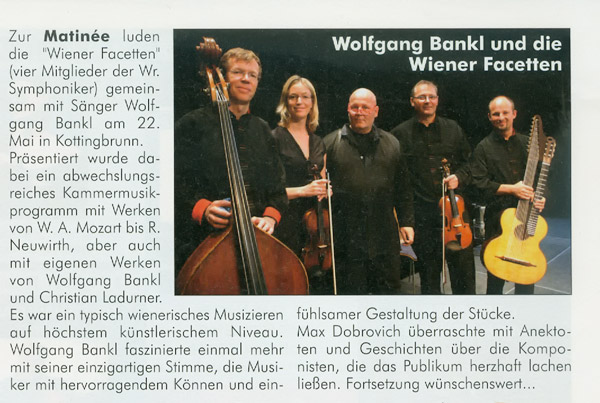City-NEWS Bad Vöslau Juni 2011

Sounds of Vienna in the Castle
But when 'real' Viennese musicians make all facets of sound and humour ring out from the Danube over the Vorarlberg mountains during the festival period, like recently at the Schattenburg castle, a long queue of Vienna fans forms to enter the room.
And so, the quintet of top level Viennese musicians provided a truly diverse mix of artistic pieces from Vienna.
Heimat Feldkirch, 23.7.2009
Melancholy masters
Multiple pieces of Vienna-inspired music were at the heart of an evening concert in the cultural factory.
Hainburg – Aptly for the date of the event, the day of Carnival, the Hainburg-based Haydngesellschaft's final concert was based around the idea of Viennese humour. However, the guest performance in the cultural factory by the Ensemble Wiener Facetten was not only about top class musical entertainment, for example with Josef Lanners "Oh, es is guat" (Oh, it is good) and Gerhard Bronner's "Der Hydrant" (The hydrant).
True to its name, the orchestra presented many different facets of music that are associated with Vienna as a city of culture. For example, Mozart's dramatic string quintet no. 2 in c-minor was followed up with the ever-more lively 'Zingarese' by Joseph Haydn.
Violinist, contraguitarist and singer Martin Ortner added to the diverse pieces of music with anecdotes and amusing stories. He told of how Haydn called one of his most successful pieces of work a 'rubbish minuet' and was thus treated with hostility by an unrecognising musician.
Two Schwermut masters were also represented on the evening: three pieces by Antonin Dvoráks von Ortner as 'echoes of a cycle of love songs' had a melancholy yet playful nature. Georg Danzer's 'Schweres Blut' ('Thick blood') also created a melancholy atmosphere with a hint of black humour with the insight that "there is nothing is more embarrassing than a failed suicide".
Niederösterreichische Nachrichten NÖN, Woche 09/2009 S. 58
On the lighter and darker sides of the Viennese spirit
BRAHMS WEEK Ensemble 'Wiener Facetten' with music and songs from Haydn to Bronner
OLDENBURG – If people are a product of their environment, then the audience at the seventh concert of Brahms week in the Villa Gartenstrasse received an insight into how the environment in Vienna could have affected Hamburg-born Johannes Brahms. If Brahms used powerful creations to win over people's hearts, then this also lay in his ability to combine the sublime with the popular.
The ability to reveal the ostensibly comprehensible in the sometimes unfathomable Austrian spirit is the forte of the Ensemble Wiener Facetten. The five members of the Viennese symphony orchestra thereby reveal the intricacies and darker sides through the refinement and deceit of Don Giovanni's Serenade and the coarseness of Georg Danzer's observation that "there is nothing more embarrassing than a failed suicide". However, death is still used to create a relaxed atmosphere in the capital, with the five musicians merrily believing that "we are born to die".
However, before they all "push up the daisies", the Viennese orchestra let rip in Oldenburg. Martin Ortner, who addressed the audience, played guitar and sang exceptionally well, carefully translated a few things into Northern German, very cleverly and with room for imagination. Christian Ladurner was the ingenious arranger, creating the viola-based atmosphere and using plucked instruments to remove the emphasis from the sound of the violins (Maximilian Dobrovich and Eva-Maria Kabas). Martin Kabas rounded off the string quartet with his contrabass, as well as taking up his accordion for the "truly beautiful, sentimental pieces".
The evening's lively program included some exciting new discoveries and some popular songs, but no generally banal practical music. The direct contrast of the refined, well-balanced Suspension Bridge waltz by Johann Strauss's father and Joseph Lanner's melodically beautiful yet simple dances is striking. After all, the oldest Viennese king of waltz wrote for the dance floor, not the philharmonic orchestra.
www.nwzonline.de, January 2009
